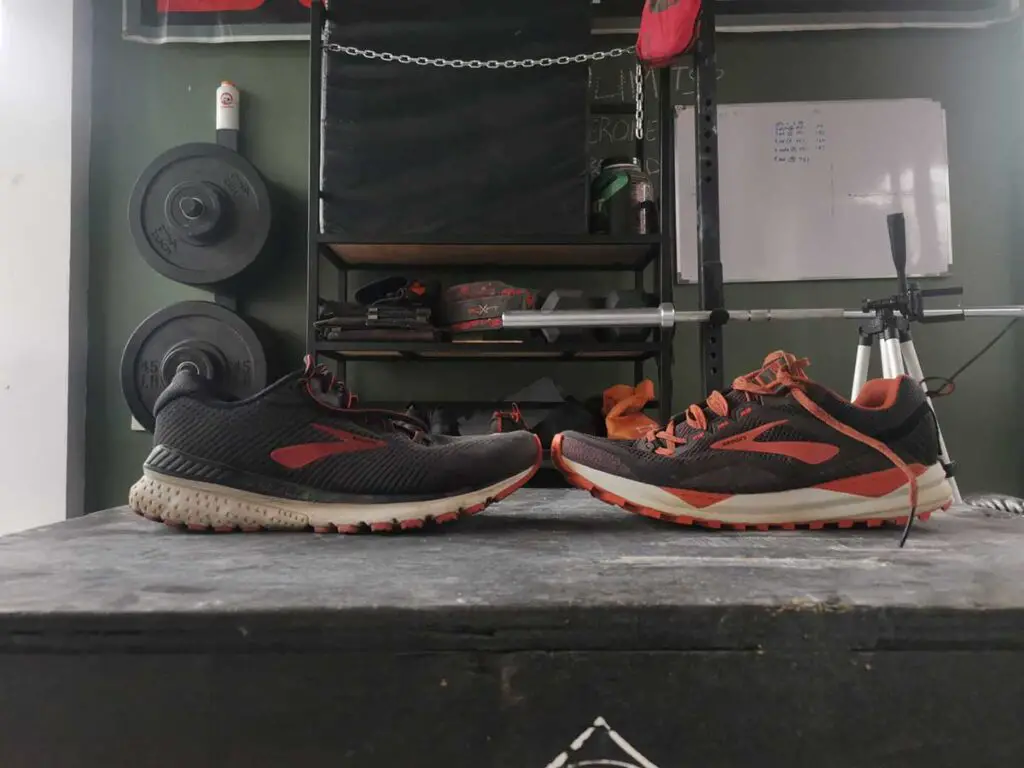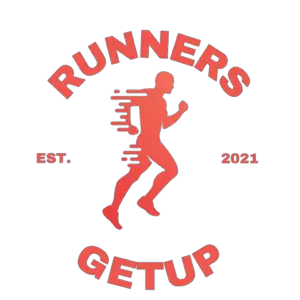This post contains affiliate links.
When I first got into trail running, I thought I could buy a pair of regular running shoes and use them on the trail. However, I was told by a friend of mine, the one who convinced me to start trail running, that trail running shoes are very different from road running shoes and convinced me to get a pair of both.
I was curious what the real difference was. So I researched and tried running on both shoes on the trail to see what the difference was. Here’s what I found.
Trail running shoes have a harder outsole with deeper lugs to provide grip and protection on foot. In addition, they are meant to run on uneven terrain which makes them more stable than road running shoes.
Ahead, we will discuss whether you really need a pair of trail running shoes as well as look deeper into the differences between trail running shoes and road running shoes from each other.
Trail Running Shoes Vs. Road Running Shoes: What’s the difference?

The main difference between road running shoes and trail running shoes is design and performance.
Road running shoes are geared towards running on hard, even pavement. They usually have softer cushioning to improve shock absorption, a smoother outsole, and more flexibility.
Trail running shoes, on the other hand, are geared towards running in various terrains with lots of debris. Trail running shoes have better grip, protection, and stability. Most often they are equipped with rock plates to add more protection against sharp rocks and tree branches that could puncture your foot.
In addition, trail running shoes usually have a wider platform to provide better stability.
DIFFERENCES OF TRAIL AND ROAD RUNNING SHOES BASED ON COMPONENTS
As I was visually comparing my trail running shoes from my road running shoes, there are quite a lot of obvious differences between the two. I summarized it here in the table below.
| Road Shoes | Trail Shoes | |
| Upper | Lighter and more breathable | Thicker and more protective |
| Midsole | Light and Soft | Dense and firm |
| Outsole | Smoother and has shallow lugs | Harder and have deep lugs. Usually equipped with rock plates |
| Stack height | Usually high for more cushioning | Usually low for more stability |
DIFFERENCES OF TRAIL AND ROAD RUNNING SHOES BASED ON PERFORMANCE
I’ve run in both shoe types on the road and trail just to see how they measure up against one another.
As I ran using my trail running shoes and road running shoes on both the road and the trail, I quickly grasped the differences between the two in terms of performance. I summarized the differences in this table below.
| Road Shoes | Trail Shoes | |
| Cushioning | More | Less |
| Grip | Less | More |
| Stability | Less | More |
| Protection | Less | More |
| Flexibility | More | Less |
| Speed | More | Less |
Although these are the common differences between the two, road running shoes can also be firm and responsive with a lower stack height. Take Saucony Kinvara 12, for example.
In contrast, trail running shoes can also be well cushioned and have a higher stack height like the Hoka One One Evo Mafate 2.
Can you run on the road with trail running shoes?
The short answer is yes, you can. But it won’t be as comfortable as running in a road running shoe. Aggressive trail running shoes tend to be firmer which makes you feel more beat up after each run compared to running in well-cushioned road shoes.
Also, I wouldn’t recommend using your trail shoes on the pavement for running and walking because it will wear off the lugs on your trail shoes faster. When that happens, it will no longer have the grip it once had.
However, there are trail running shoes with just enough lugs cushioning, and flexibility that you can use them on light trails and roads. Some runners call this a commuter shoe.
An example of this shoe is the Asics Gel-Venture 7. It has deep enough lugs to provide grip on wet surfaces and buffed-out trails while still having the benefits of a Gel cushioning. The best part? They’re affordable. You can check the price on Amazon.
Do you really need a trail running shoe?
I’ve run with a regular road running shoe on trails and I can tell you this with certainty, it won’t go well for aggressive trails.
So the answer to whether or not you really need a trail running shoe is YES. If you run on technical trails, wet trails, or trails with a lot of rocks and debris, then you will need trail running shoes for your own safety.
Here are a few benefits of running on a trail with a trail running shoe.
- Provides a better grip on all types of surfaces
- Gives your foot better protection from rocks and debris
- Has a wider, more stable platform that helps reduce the chances of breaking an ankle
- Gives you confidence when running on trails
- Improves your performance on trail running
For light and paved trails that compose just a small part of your run, a road running shoe with a decent outsole will do.

Take a look at these 3 shoes for example. On the left is a trail running shoes made for running in technical terrain. It has deep lugs that ensure grip even on wet surfaces.
At the center is an Adidas Ultraboost 21 Prime. It has very little lug depth which doesn’t make me confident running in trails.
Lastly, the Brooks Adrenaline GTS 20 has a decent lug depth and a good amount of blown rubber outsole which makes me confident that I can use this to run in very light trails.
How to choose the right trail running shoe
If you are not familiar with trail running shoes yet, trail running shoes are made for different running conditions.
Some have more aggressive lugs that emphasize traction on muddy trails while others have shallow lugs with higher stack height that emphasize cushioning and are perfect for trail running on less technical trails.
Choosing the right running shoe will depend on the type of trail you’re running in, the type of running you usually do, and how you pronate when you run.
If you’re still wondering, check out my article that goes deeper into how to choose a running shoe.
Although most of it was on a more general level, you can pick up a good idea on how to choose a running shoe.
Recommended trail running shoes
If you’re having a hard time choosing a trail running shoe, let me make it simple for you by giving you a few trail running shoe recommendations.
ASICS Gel-Venture 7
- Type of trail: Buffed out
- Type of cushioning: Soft
- Traction level: Medium
- Running type: Easy run
- Budget type: Low
- Recommended for: Those on a tight budget looking for a shoe they can use on light trails and road
First on the list is the ASICS Gel-Venture 7. I highly recommend this for easy runs on a buffed-out trail (trails where there are only a few rocks and debris) as well as for those on a tight budget who’s looking for a running shoe they can use to run on the road and trails.
Salomon Speedcross 5
- Type of trail: Technical, Muddy, and soft
- Type of cushioning: Firm
- Traction level: High
- Running type: Fartlek
- Budget type: Medium
- Recommended for: Those who are looking for a do-it-all trail running shoe you can use on different types of trails
The Salomon Speedcross 5 is a very versatile trail running shoe. You can use it on easy runs, long-distance runs on any type of trail. However, it excels in muddy and soft trails. It has very aggressive lugs that give you the confidence to run fast even on wet trails.
Hoka Speedgoat 4
- Type of trail: Buffed out and technical
- Type of cushioning: soft
- Traction level: Medium
- Running type: Long distance
- Budget type: High
- Recommended for: Long-distance trail running
The Speedgoat 4 is highly recommended for long runs on buffed-out and technical trails. It has a very soft cushion that helps keep you fresh even on long runs. In addition, it has a good grip that gives you confidence on any trail. The only downside is, it’s quite expensive.
Salomon S/Lab Sense 8 SG
- Type of trail: Technical, muddy and soft
- Type of cushioning: Responsive
- Traction level: High
- Running type: Fast pace/ race
- Budget type: Medium
- Recommended for: Racing and fast-paced running.
The Salomon S/Lab Sense 8 is light and responsive that makes for a perfect racing shoe. I highly recommend it for those who like to go fast on any type of trail. In addition, it has a built-in mud gaiter that keeps the mud out of your socks and foot on muddy trails.
Brooks Cascadia 15
- Type of trail: Technical trails
- Type of cushioning: Soft
- Traction level: Medium
- Running type: Middle to long-distance run
- Budget type: Medium
- Recommended for: Those looking for a soft trail running shoe that gives great foot protection
The Brooks Cascadia 15 offers great foot protection that is perfect for technical trails. As a matter of fact, I use a Cascadia 14 for most of my training (I usually run on very technical trails, usually on mountains). Both the 14 and 15 are very similar to each other.
The Wrap Up
Trail running shoes provide your foot with protection against debris as well as give you a better grip on different surfaces.
Therefore, trail running shoes provide you with more options on terrains. They are a great addition to your running shoe rotation.





